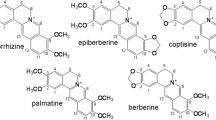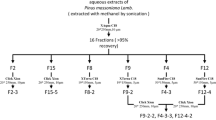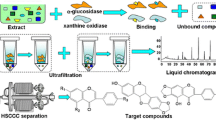Abstract
Phosphodiesterase (PDE) inhibitors are widely used because of their various pharmacological properties, and natural products are considered the most productive source of PDE inhibitors. In this work, a new ultrafiltration–high-performance liquid chromatography (HPLC)–diode-array detection–mass spectrometry based ligand screening was developed for the first screening of PDE inhibitors from Eucommia ulmoides bark, and then the target bioactive compounds were prepared by combination of stepwise preparative HPLC and high-speed countercurrent chromatography (HSCCC) methods. Experiments were conducted to optimize the parameters in ultrafiltration, stepwise preparative HPLC, and HSCCC to allow rapid and effective screening and isolation of active compounds from complex mixtures. Seven lignans with purity over 97 % were isolated and identified by their UV, electrospray ionization mass spectrometry, and NMR data as (+)-pinoresinol-4,4′-di-O-β-D-glucopyranoside (1), (+)-pinoresinol-4-O-β-D-glucopyranosyl(1 → 6)-β-D-glucopyranoside (2), (+)-medioresinol-4,4′-di-O-β-D-glucopyranoside (3), (+)-syringaresinol-4,4′-di-O- β-D-glucopyranoside (4), (−)-olivil-4′-O-β-D-glucopyranoside (5), (−)-olivil-4-O-β-D- glucopyranoside (6), and (+)-pinoresinol-4-O-β-D-glucopyranoside (7). Compound 2 was first isolated from the genus Eucommia. Lignan diglucopyranosides (compounds 1–4) shower a greater inhibitory effect than lignan monoglucopyranosides (compounds 5–7). The method developed could be widely applied for high-throughput screening and preparative isolation of PDE inhibitors from natural products.





Similar content being viewed by others
References
Newman DJ, Cragg GM (2007) Natural products as sources of new drugs over the last 25 years. J Nat Prod 70:461–477
Wang X, Li KF, Adams E, Van Schepdael A (2011) Matrix metalloproteinase inhibitors: a review on bioanalytical methods, pharmacokinetics and metabolism. Curr Drug Metabol 12:395–410
Omori K, Kotera J (2007) Overview of PDEs and their regulation. Circ Res 100:309–327
Schenk T, Breel GJ, Koevoets P, van den Berg S, Hogenboom AC, Irth H, Tjaden UR, van den Greef J (2003) Screening of natural products extracts for the presence of phosphodiesterase inhibitors using liquid chromatography coupled online to parallel biochemical detection and chemical characterization. J Biomol Screen 8:421–429
Rahimi R, Ghiasi S, Azimi H, Fakhari S, Abdollahi M (2010) A review of the herbal phosphodiesterase inhibitors: future perspective of new drugs. Cytokine 49:123–129
Bender AT, Beavo JA (2006) Cyclic nucleotide phosphodiesterases: molecular regulation to clinical use. Pharmacol Rev 58:488–520
Hong ND, Rho YS, Won DH, Kim NJ, Cho BS (1987) Studies on the anti-diabetic activity of Eucommia ulmoides Oliver. Korean J Pharmacog 18:112–117
Horii Y, Tanida M, Shen J, Hirata T, Kawamura N, Wada A, Nagai K (2010) Effects of Eucommia leaf extracts on autonomic nerves, body temperature, lipolysis, food intake, and body weight. Neurosci Lett 479:181–186
Park SA, Choi MS, Jung UJ, Kim MJ, Kim DJ, Park HM, Park YB, Lee MK (2006) Eucommia ulmoides Oliver leaf extract increases endogenous antioxidant activity in type 2 diabetic mice. J Med Food 9:474–479
National Commission of Chinese Pharmacopoeia (2010) Pharmacopoeia of the People's Republic of China, vol 1. China Medical Science and Technology Press, Beijing, P 154
Deyama T, Nishibe S, Nakazawa Y (2001) Constituents and pharmacological effects of Eucommia and Siberian ginseng. Acta Pharmacol Sin 22:1057–1070
Takamura C, Hirata T, Ueda T, Ono M, Miyashita H, Ikeda T, Nohara T (2007) Iridoids from the green leaves of Eucommia ulmoides. J Nat Prod 70:1312–1316
Takamura C, Hirata T, Yamaguchi Y, Ono M, Miyashita H, Ikeda T, Nohara T (2007) Studies on the chemical constituents of green leaves of Eucommia ulmoides Oliv. J Nat Med 61:220–221
Luo LF, Wu WH, Zhou YJ, Yan J, Yang GP, Ouyang DS (2010) Antihypertensive effect of Eucommia ulmoides Oliv extracts in spontanesously hypertensive rats. J Ethnopharmacol 129:238–243
Sha ZF, Sun WJ (1986) High performance liquid chromatography of pinoresinol diglucoside in Eucommia ulmoides Oliv bark. Acta Pharmaceut Sin 21:708–711
Li L, Yan J, Hu K, Gu J, Wang JJ, Deng XL, Li H, Jing X, Li ZY, Ye QF, Ouyang DS (2012) Protective effect of Eucommia lignans against hypertensive renal injury by inhibiting expression of aldose reductase. J Ethnopharmacol 139:454–461
Gu J, Wang JJ, Yan J, Cui CF, Wu WH, Li L, Wang ZS, Yu M, Gao N, Liu L, Ouyang DS (2011) Effect of lignans extracted from Eucommia ulmoides and aldose reductase inhibitor epalrestat on hypertensive vascular remodeling. J Ethnopharmacol 133:6–13
Deyama T, Nishibe S, Kitagawa S, Ogihara Y, Takeda T, Ohmoto T, Nikaido T, Sankawa U (1988) Inhibition of adenosine 3',5'-cyclic monophosphate phosphodiesterase by lignin glucosides of Eucommia bark. Chem Pharm Bull 36:435–439
Wen XD, Qi LW, Chen J, Song Y, Yi L, Yang XW, Li P (2007) Analysis of interaction property of bioactive components in Danggui Buxue decoction with protein by microdialysis coupled with HPLC-DAD-MS. J Chromatogr B 852:598–604
Ye G, Li YZ, Li YY, Guo HZ, Guo DA (2003) SPE-HPLC method for the determination and pharmacokinetic studies on pqeoniflorin in rat serum after oral administration of traditional Chinese medicinal preparation Guan-Xin-Er-Hao decoction. J Pharm Biomed Anal 33:521–527
Robards K (2003) Strategies for the determination of bioactive phenols in plants, fruit and vegetables. J Chrom A 1000:657–691
Shi SY, Zhou HH, Zhang YP, Jiang XY, Chen XQ, Huang KL (2009) Coupling HPLC to on-line, post-column (bio)chemical assays for high-resolution screening of bioactive compounds from complex mixtures. Trends Anal Chem 28:865–877
Roldán C, de la Torre A, Mota S, Morales-Soto A, Menédez J, Segura-Carretero A (2013) Identification of active compounds in vegetal extracts based on correlation between activity and HPLC-MS data. Food Chem 136:392–399
Li YJ, Chen J, Li Y, Li Q, Zheng YF, Fu Y, Li P (2011) Screening and characterization of natural antioxidants in four Glycyrrhiza species by liquid chromatography coupled with electrospray ionization quadrupole time-of-flight tandem mass spectrometry. J Chrom A 1218:8181–8191
Dapkevicius A, van Beek TA, Niederländer HAG (2011) Evaluation and comparison of two improved techniques for the on-line detection of antioxidants in liquid chromatography eluates. J Chrom A 912:73–82
Zhang YP, Shi SY, Xiong X, Chen XQ, Peng MJ (2012) Comparative evaluation of three methods based on high-performance liquid chromatography analysis combined with a 2,2'-diphenyl-1-picrylhydrazyl assay for the rapid screening of antioxidants from Pueraria lobata flowers. Anal Bioanal Chem 402:2965–2976
Kunihiro K (2011) Simplified extraction of tetracycline antibiotics from milk using a centrifugal ultrafiltration device. Food Chem 126:687–690
Yang ZZ, Zhang YF, Sun LJ, Wang Y, Gao XM, Cheng YY (2012) An ultrafiltration high-performance liquid chromatography coupled with diode array detector and mass spectrometry approach for screening and characterizing tyrosinase inhibitors from mulberry leaves. Anal Chim Acta 719:87–95
Qian ZM, Qin SJ, Li P, Li HJ, Li P, Wen XD (2008) Binding study of Flos Lonicerae Japonicae with bovine serum albumin using centrifugal ultrafiltration and liquid chromatography. Biomed Chromatogr 22:202–206
Chen XP, Xia YQ, Lu Y, Liang JY (2011) Screening of permeable compounds in Flos Lonicerae Japonicae with liposome using filtration and HPLC. J Pharm Biomed Anal 54:406–410
Luo YD, Wu SS, Li XY, Li P (2010) LC-ESI-MS-MS determination of rat plasma protein binding of major flavonoids of Flos Lonicerae Japonicae by centrifugal ultrafiltration. Chromatographia 72:71–77
Zhang YP, Peng MJ, Liu LL, Shi SY, Peng S (2012) Screening, identification and potential interaction of active compounds from Eucommia ulmodies leaves binding with bovine serum albumin. J Agric Food Chem 60:3119–3125
Lo TC, Nian HC, Chiu KH, Wang AY, Wu BZ (2012) Rapid and efficient purification of chrysophanol in Rheum Palmatum LINN by supercritical fluid extraction coupled with preparative liquid chromatography in tandem. J Chromatogr B 893–894:101–106
Ito Y (2005) Golden rules and pitfalls in selecting optimum conditions for high-speed counter-current chromatography. J Chrom A 1065:145–168
Shi SY, Ma YJ, Zhang YP, Liu LL, Liu Q, Peng MJ, Xiong X (2012) Systematic separation and purification of 18 antioxidants from Pueraria lobata flower using HSCCC target-guided by DPPH-HPLC experiment. Sep Purif Technol 89:225–233
Schroder M, Vetter W (2011) High-speed counter-current chromatographic separation of phytosterols. Anal Bioanal Chem 400:3615–3623
Yoon KD, Chin YW, Yang MH, Kim J (2011) Separation of anti-ulcer flavonoids from Artemisia extracts by high-speed countercurrent chromatography. Food Chem 129:679–683
DeAmicis C, Edwards NA, Giles MB, Harris GH, Hewitson P, Janaway L, Ignatova S (2011) Comparison of preparative reversed phased liquid chromatography and countercurrent chromatography for the kilogram scale purification of crude spinetoram insecticide. J Chrom A 1218:6122–6127
Yamazaki T, Anraku T, Matsuzawa S (2011) Ibudilast, a mixed PDE3/4 inhibitor, causes a selective and nitric oxide/cGMP-independent relaxation of the intracranial verbrobasilar artery. Eur J Pharmacol 650:605–611
Kebarle P, Verkerk UH (2009) Electrospray: from ions in solution to ions in the gas phase, what we know now. Mass Spectrum Rev 28:898–917
Sun L, Li HK, Willson K, Breidinger S, Rizk ML, Wenning L, Woolf EJ (2012) Ultrasensitive liquid chromatography-tandem mass spectrometric methodologies for quantification of five HIV-1 integrase inhibitors in plasma for a microdose clinical trial. Anal Chem 84:8614–8621
Noguchi S, Shimura G, Kimura K, Samejima H (1976) Production of 5'-mononucleotides using immobilized 5'-phosphodiesterase and 5'-AMP deaminase. Appl Biochem Biotechnol 2:105–118
Abe F, Yamauchi T, Wan ASC (1988) Lignans related to olivil from Cerbera (Cerbera. VI). Chem Pharm Bull 36:795–799
Deyama T (1983) The constituents of Eucommia ulmoides Oliv. I. Isolation of (+)-medioresinol di-O-β-D-glucopyranoside. Chem Pharm Bull 31:2993–2997
Katsuzaki H, Osawa T, Kawakishi S (1994) Chemistry and antioxidative activity of lignan glucosides in sesame seed. In: Ho C-T, Osawa T, Huang M-T, Rosen RT (eds) Food phytochemicals for cancer prevention II. American Chemical Society, Washington, pp 275–280
Acknowledgments
This work was supported by the National Natural Science Foundation of China (21275163, 21005089), the Science and Technology Program of Hunan Province, China (2012FJ2006), the Freedom Explore Program of Central South University (201012200015), the Shenghua Yuying project of Central South University, the Open Fund of the Key Laboratory of Hunan Forest Products and Chemical Industry Engineering, and the Aid Program for Science and Technology Innovative Research Team (Chemicals of Forestry Resources and Development of Forest Products) in Higher Educational Institutions of Hunan Province.
Author information
Authors and Affiliations
Corresponding author
Rights and permissions
About this article
Cite this article
Shi, SY., Peng, MJ., Zhang, YP. et al. Combination of preparative HPLC and HSCCC methods to separate phosphodiesterase inhibitors from Eucommia ulmoides bark guided by ultrafiltration-based ligand screening. Anal Bioanal Chem 405, 4213–4223 (2013). https://doi.org/10.1007/s00216-013-6806-4
Received:
Revised:
Accepted:
Published:
Issue Date:
DOI: https://doi.org/10.1007/s00216-013-6806-4




